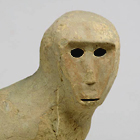Japanese Archaeology and Special Exhibition (Heiseikan) Thematic Exhibition Room
May 8, 2013 (Wed) - June 16, 2013 (Sun)
Monkeys have inhabited the Japanese archipelago since ancient times. Together with the development of human culture in Japan, monkeys have appeared on implements and in sayings, paintings, stories and other media.
Scenes of a baby monkey clinging to its mother, monkeys living in troops, or monkeys finding and eating food, probably resonated closely with human life. From these scenes, humans created a wide variety of monkey images, resulting in objects featuring monkeys in many fields of art.
The history of Japanese objects based on monkey motifs goes back to the Jomon period. Many of these objects show the Japanese macaque. However, when depictions of monkeys painted by the Chinese artist, Muqi Fachang, were brought to Japan in the 13th century, they changed the artistic representation of monkeys. In addition to portraying monkeys through existing styles of realism, various other types of monkey, including imaginary ones, were depicted or created.
From the many objects featuring monkeys in the museum collection, this thematic exhibition focuses on "Monkeys in Life" and "Monkeys in Painting." In modern times in Japan, chances to see monkeys in everyday life have largely disappeared. We hope visitors are able to imagine real monkeys while appreciating the museum's monkeys.
This thematic exhibition is held in connection to a collaborative event about animals by three institutions, which is one part of "Ueno Museum Week," a commemorative event to mark International Museum Day (established by ICOM (International Council of Museums)).

